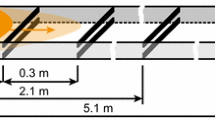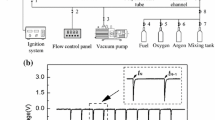Abstract
Detonation experiments in H2–NO2/N2O4–Ar mixtures (Equivalence ratio 1.2 and initial pressure lower than 0.1 MPa) confined in a tube of internal diameter 52 mm reveal two propagation regimes depending on initial pressure: (1) a quasi-CJ regime is observed along with a double cellular structure at high pressures; (2) at lower pressures, a low velocity detonation regime is observed with a single structure. Transition between this two regimes happens when the spinning detonation of the larger cell vanishes. Each detonation regime is characterized by velocity and pressure measurements and cellular structure records. Coherence between all experimental data for each experiment leads in assumption that losses are responsible for the transition between one regime to another. In a second part, we study such behaviour for a two-step mixture through numerical simulations using a global two-step chemical kinetics and a simple losses model. Numerical simulations qualitatively agree with experiments. Both detonation regimes with their own cellular structures are reproduced.
Similar content being viewed by others
Abbreviations
- c v :
-
Heat capacity at constant volume
- d :
-
Channel width or tube diameter
- D :
-
Detonation velocity
- E :
-
Total energy
- Ea i :
-
Activation energy of reaction i
- n i :
-
Order of reaction i
- p :
-
Pressure
- p 0,t :
-
Initial pressure where transition is observed
- Q i :
-
Heat of reaction of step i
- R :
-
Perfect gas constant
- T :
-
Temperature
- \({\overrightarrow{V}}\) :
-
Particle velocity
- x i :
-
Mole number of species i
- X i :
-
Molar fraction of species i
- Y i :
-
Mass fraction of species i
- Z i :
-
Pre-exponential factor of reaction i
- W m :
-
Molecular weight
- \({\phi}\) :
-
Equivalence ratio
- γ :
-
Polytropic coefficient c p /c v
- λ:
-
Detonation cell size
- ρ :
-
Density
- σ :
-
Thermicity
References
Presles H.N., Desbordes D., Guirard M., Guerraud G.: Gaseous nitromethane and nitromethane–oxygen mixtures: a new detonation structure. Shock Waves 6, 111–114 (1996)
Joubert F., Desbordes D., Presles H.N.: Detonation cellular structure in NO2/N2O4—fuel gaseous mixtures. Combust. Flame 152, 482–495 (2008)
Lamoureux N., Matignon C., Sturtzer M.O., Desbordes D., Presles H.N.: Interprétation de la double structure observée dans l’onde de détonation du nitrométhane gazeux. C. R. Acad. Sci. Paris 329(IIb), 687–692 (2001)
Djebaïli-Chaumeix, N., Abid, S., Paillard, C.E.: Shock tube study of the nitromethane decomposition and oxidation. 21st Symposium on Shock Waves, vol. 1, pp. 121–126 (1997)
Konnov, A.A.: Development and validation of a detailed reaction mechanism for the combustion of small hydrocarbons. 28th Symposium (International) on Combustion, Edinburgh (2000)
Desbordes D., Presles H.-N., Joubert F., Gbagdo Douala C.: Etude de la détonation de mélanges pauvres H2–NO2/N2O4. C. R. Mecanique 332, 993–999 (2004)
Luche J., Desbordes D., Presles H.N.: Détonation de mélanges H2–NO2/N2O4–Ar. C. R. Mecanique 334, 323–327 (2006)
Desbordes D., Lannoy A.: Effect of a negative step of fuel concentration on critical diameter of diffraction of a detonation. Prog. Astronaut. Aeronaut. 133, 170–186 (1991)
Joubert, F.: Etude de la détonation de mélanges réactifs constitués d’un combustible (H2, CH4, C2H6, C2H4) et d’un oxyde d’azote (N2O, NO2/N2O4). PhD thesis, Université de Poitiers (2001)
Luche, J., Desbordes, D., Presles, H.-N.: Study of overdriven detonation of H2–NO2/N2O4 mixtures. In: Proceedings of 20th ICDERS Montreal (2005)
Manzhalei V.I.: Fine structure of the leading front of a gas detonation. Combust. Explos. Shock Waves (USSR) 13(3), 402–404 (1977)
Virot F., Khasainov B., Desbordes D., Presles H.N.: Numerical simulation of the influence of tube diameter on detonation regimes and structures in 2-step/2-cell mixtures. Combust. Explos. Shock Waves 45(4), 435–441 (2009)
Korobeinikov V.P, Levin V.A.: Propagation of blast waves in a combustible gas. Astronaut. Acta 17, 437–520 (1972)
Oran E.S., Young T., Boris J.P., Cohen A.: Weak and strong ignition. I. Numerical simulations of shock tube experiments. Combust. Flame 48, 135–161 (1982)
Author information
Authors and Affiliations
Corresponding author
Additional information
Communicated by L. Bauwens.
This paper is based on work that was presented at the 22nd International Colloquium on the Dynamics of Explosions and Reactive Systems, Minsk, Belarus, July 27–31, 2009.
Rights and permissions
About this article
Cite this article
Virot, F., Khasainov, B., Desbordes, D. et al. Two-cell detonation: losses effects on cellular structure and propagation in rich H2–NO2/N2O4–Ar mixtures. Shock Waves 20, 457–465 (2010). https://doi.org/10.1007/s00193-010-0283-x
Received:
Revised:
Accepted:
Published:
Issue Date:
DOI: https://doi.org/10.1007/s00193-010-0283-x




